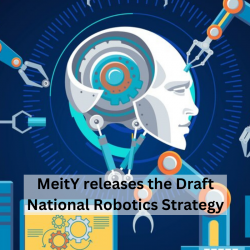Will Robotics Transform the Security, Defense, and Aerospace Sectors?

Introduction to Will Robotics Transform the Security, Defense, and Aerospace Sectors
Welcome to our blog! Today, we will be delving into the topic of robotics and its potential impact on the security, defense, and aerospace sectors. As technology continues to advance at a rapid pace, the use of robotics has become more prevalent in various industries. The question we want to explore is, “Will Robotics Transform the Security, Defense, and Aerospace Sectors?”
Firstly, let’s discuss why it is important to even consider this question. In today’s world, security is a top priority for governments and organizations alike. With the increasing threat of cyberattacks and physical threats from adversaries, there is a constant need to stay ahead in terms of security measures.
One aspect that needs to be considered when discussing the impact of robotics on security, defense, and aerospace is efficiency. With autonomous robots being able to perform tasks without human intervention, they can potentially increase efficiency in these sectors.
Another potential impact of robotics on these sectors is increased accuracy. Robots are programmed with precision based algorithms that allow them to carry out tasks with minimal errors. This could significantly benefit security forces in accurately identifying threats or assist soldiers in accurately targeting enemies during combat.
On the other hand, there are concerns about job displacement due to increased automation through robotics. Human workers may fear losing their jobs as robots become more advanced and capable of performing tasks traditionally done by humans.
History of Robotics in Security, Defense and Aerospace Sectors
The history of robotics in security dates back to the early 1920s when the first robot was created by Czech author Karel Čapek. However, it wasn’t until World War II that robotics gained significance in the field of security. This war saw the widespread use of robots for detecting and clearing landmines, bomb disposal, and reconnaissance missions.
With the advancement of technology, robots began to play a vital role in security operations. In the 1960s and 1970s, unmanned aerial vehicles (UAVs) were developed for surveillance purposes by both military and civilian organizations. This marked the beginning of automated systems being used for border control and monitoring sensitive areas.
The 1990s saw a significant breakthrough with robotic systems being used for disaster response efforts. These machines proved to be extremely useful in risky situations such as nuclear accidents or natural disasters where human intervention was limited or dangerous.
In recent years, there has been a surge in the use of robotics in law enforcement. Drones are now being used for crowd control, identifying suspects from a safe distance, and even delivering supplies during emergency situations.
Moving on to the defense sector, robotics has revolutionized warfare tactics with its ability to perform tasks that are too dangerous or impossible for humans. This includes bomb disposal robots that are remotely operated to navigate explosive devices safely.
Advancements in Robotics Technology for Security, Defense and Aerospace
Advancements in robotics technology have had a significant impact on security, defense, and aerospace industries. These advancements have improved efficiency, safety, and the ability to perform tasks in challenging and high-risk environments. Here are some key developments in each of these sectors:
Security:
- Surveillance and Reconnaissance: Unmanned aerial vehicles (UAVs) and ground-based robots equipped with advanced sensors and cameras have enhanced surveillance capabilities. They can monitor large areas and provide real-time data to security personnel.
- Bomb Disposal: Bomb disposal robots are equipped with manipulator arms and remote-controlled capabilities, allowing them to safely handle and defuse explosive devices.
- Autonomous Security Patrols: Robots with autonomous navigation capabilities are used for patrolling sensitive areas, such as airports and critical infrastructure. They can detect anomalies, intruders, and security breaches.
Defense:
- Unmanned Aerial Vehicles (UAVs): Drones have become essential in modern warfare for reconnaissance, surveillance, and even offensive operations. They can fly into hostile territories without putting human lives at risk.
- Unmanned Ground Vehicles (UGVs): UGVs can be used for a variety of tasks, including logistics, reconnaissance, and combat. They can clear minefields, transport supplies, and provide direct support on the battlefield.
- Autonomous Weapons: The development of autonomous or semi-autonomous weapons systems, such as drones and combat robots, is an ongoing trend. These systems can make rapid decisions based on data and reduce the need for human intervention.
Aerospace:
- Space Exploration: Robotics plays a crucial role in space exploration. Robotic arms are used in space missions to manipulate objects, conduct experiments, and perform repairs. Rovers like the Mars rovers have explored other planets and moons.
- Aircraft Manufacturing: Aerospace manufacturers use advanced robotic systems in the assembly and quality control of aircraft components, improving precision and efficiency.
- Autonomous Drones: Drones are used for various aerospace applications, including aerial surveys, monitoring, and cargo transport. These drones can operate autonomously, even in complex environments.
Use Cases of Robotics in the Sectors
The integration of robots in these industries has been driven by the need for enhanced safety, improved efficiency, and reduced costs. In the security sector, robots are used for surveillance and patrolling purposes. They can be equipped with advanced sensors and cameras to monitor areas that may be challenging or dangerous for humans to access.
Similarly, in the defense sector, robotics has played a crucial role in enhancing military capabilities. Drones or unmanned aerial vehicles (UAVs) have become increasingly popular in modern warfare due to their ability to gather intelligence, carry out strikes, and reduce risks for soldiers on the ground.
In addition to drones, land based robots are also being used in various defense operations such as bomb disposal and reconnaissance missions. These robots can navigate through rugged terrain and hazardous environments that would be difficult for humans to access safely. They also have the advantage of being equipped with hightech tools such as sensors and cameras, making them valuable assets on the battlefield.
The aerospace industry is another sector where robotics has made significant strides. The use of robots in manufacturing processes has increased efficiency and precision while reducing costs. Robots are used in tasks such as welding, painting, drilling, and assembly of aircraft components.
Impact on Workforce and Job Skills
Firstly, let’s talk about how robotics has already started to transform the security sector. Traditional security measures such as manual patrolling and CCTV surveillance are slowly being replaced by advanced robots equipped with sensors and cameras. These robots can cover large areas efficiently and effectively without any human intervention. They can also detect suspicious activities and report them in realtime to a control center.
But what does this mean for jobs in the security sector? It is true that with the increased use of robots, there will be a decrease in certain job roles such as security guards or surveillance operators. However, it also opens up opportunities for individuals with relevant technical skills to operate and maintain these robots. Companies will need skilled technicians who can handle repairs, updates, and programming of these machines.
Similarly, in the defense sector, robotics technology has been playing a crucial role for quite some time now. Drones have been used extensively for aerial surveillance and combat missions. With advancements in technology, we can expect more sophisticated autonomous drones that can perform complex tasks with minimal human intervention. This will not only lead to increased efficiency but also reduce risks for soldiers on field operations.
Ethical Considerations
The use of robotics in various industries has been on the rise for quite some time now, and it’s not surprising that they have also caught the attention of those in the security, defense, and aerospace fields. But what kind of impact will robotics have on these industries? And more importantly, what ethical considerations need to be taken into account?
Let’s start by looking at how robotics could potentially transform employment in the security sector. With the use of robotic systems for surveillance and information gathering tasks, there could be a decrease in demand for human workers in this field.
On the flip side, there is also a potential for new job opportunities to emerge as companies invest in developing and maintaining these robotic systems. Engineers and technicians will be needed to design and build these machines while IT specialists will be required to manage their operations.
However, with this increase in automation comes ethical concerns surrounding data privacy and security. In order for robots to perform their duties effectively, they need access to vast amounts of information which could include sensitive data about individuals or organizations. It is crucial that proper measures are put in place to ensure that this information is used ethically and protected from any malicious intent.
The Potential Transformative Role of Robotics in the Security, Defense, and Aerospace Sectors
Certainly, here are two potential transformative roles of robotics in each of the security, defense, and aerospace sectors:
Security:
- Surveillance and Rapid Response: Robotics can revolutionize security by providing continuous surveillance and rapid response capabilities. Autonomous drones and ground-based robots equipped with advanced sensors and AI can monitor large areas, detect anomalies, and respond to security breaches in real time, significantly enhancing the effectiveness of security systems.
- Enhanced Explosive Ordnance Disposal (EOD): Bomb disposal robots and remotely operated systems can safely handle and defuse explosive devices, reducing the risk to human bomb disposal experts. These robots can be equipped with specialized tools and sensors to perform complex EOD tasks with precision.
Defense:
- Unmanned Aerial Warfare: Drones and unmanned aerial vehicles (UAVs) are transforming the defense sector by enabling remote reconnaissance, surveillance, and even combat operations. These unmanned systems can be deployed in high-risk areas without risking the lives of military personnel.
- Autonomous Combat Support: Robotics, powered by artificial intelligence, can autonomously analyze data and make decisions on the battlefield. This includes autonomous weapons systems that can identify and engage targets rapidly, enhancing the speed and efficiency of combat operations while reducing the need for human intervention.
Aerospace:
- Space Exploration and Colonization: Robots play a crucial role in space exploration, with the potential to transform humanity’s understanding of the cosmos. Robotic missions to other planets, moons, and asteroids can provide essential data for future space colonization and resource utilization.
- Advanced Manufacturing and Maintenance: In aerospace, robots are revolutionizing aircraft and spacecraft manufacturing and maintenance. Advanced robotic systems can assemble and inspect complex components with precision, reducing production costs and improving the quality of aerospace vehicles.
These examples illustrate how robotics technology has the potential to transform the security, defense, and aerospace sectors by enhancing capabilities, improving safety, and increasing efficiency in various critical operations.






Ingen kommentarer endnu